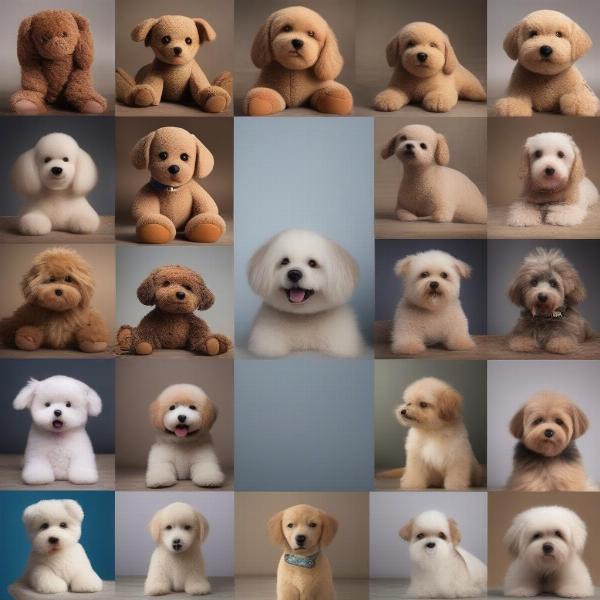Dogs and teddy bears often go hand-in-hand, representing comfort, companionship, and unconditional love. Whether it’s a puppy snuggling with a plush toy or a senior dog finding solace in a familiar furry friend, the bond between dogs and teddy bears can be incredibly strong. This article explores the various aspects of this heartwarming partnership, from the benefits of teddy bears for dogs to choosing the right one and ensuring its safety.
Why Do Dogs Love Teddy Bears?
Many dog owners have witnessed their furry companions develop a strong attachment to a particular teddy bear or other plush toy. This attachment can stem from several reasons. For puppies, a teddy bear can provide comfort and a sense of security, especially during the crucial weaning period when they are separated from their mother and littermates. The soft texture and cuddly shape can mimic the warmth and closeness of their siblings. For adult dogs, a teddy bear can offer companionship, particularly for dogs who spend time alone or suffer from anxiety. The act of cuddling, licking, and carrying a teddy bear can release endorphins, reducing stress and promoting a sense of calm. Some dogs even treat their teddy bears like surrogate puppies, nurturing and protecting them.
Choosing the Right Teddy Bear for Your Dog
Selecting a safe and durable teddy bear is essential for your dog’s well-being. Opt for toys specifically designed for dogs, as they are typically made from more robust materials and are less likely to pose choking hazards. Avoid teddy bears with small, detachable parts like buttons, eyes, or ribbons, as these can be easily swallowed. Consider your dog’s size and chewing habits when choosing a teddy bear. A small teddy bear could be a choking hazard for a large breed, while a flimsy toy might not withstand the powerful jaws of a determined chewer.
Ensuring Teddy Bear Safety
While teddy bears can offer numerous benefits, it’s crucial to prioritize safety. Regularly inspect the teddy bear for signs of wear and tear, such as loose seams or detached parts. Replace any damaged toys immediately to prevent ingestion of potentially harmful materials. Supervise your dog, especially puppies, during playtime with their teddy bear. Excessive chewing or destruction of the toy could lead to ingestion of stuffing or other materials, which can cause intestinal blockage. Washing the teddy bear regularly will help maintain hygiene and prevent the buildup of bacteria.
Teddy Bears for Dogs of All Ages
From puppies to senior dogs, a teddy bear can provide comfort and companionship throughout a dog’s life. For puppies, a teddy bear can ease the transition to a new home and provide a sense of security. For adult dogs, a teddy bear can be a source of comfort and stress relief, especially during times of anxiety or separation. Even senior dogs can benefit from the comforting presence of a familiar teddy bear, providing them with a sense of familiarity and security. pros and cons of teddy bear dogs This article helps dog owners understand more details about teddy bears for dogs.
 Teddy bears for dogs of all ages
Teddy bears for dogs of all ages
Conclusion
The bond between a dog and a teddy bear is a testament to the power of comfort and companionship. By choosing the right teddy bear and ensuring its safety, you can provide your furry friend with a source of comfort, security, and endless cuddles. dog teddy big may be a good choice for big dogs. Remember to prioritize safety and always supervise your dog during playtime with their beloved teddy bear.
FAQ
- Why does my dog carry his teddy bear everywhere? This behavior often stems from a need for comfort and security. The teddy bear can represent a companion or a source of comfort, particularly in new or stressful situations.
- Is it safe for my dog to sleep with his teddy bear? Generally, yes, as long as the teddy bear is durable and free of small, detachable parts. However, always supervise puppies and dogs with destructive chewing habits.
- How often should I wash my dog’s teddy bear? Washing it every few weeks, or more frequently if it becomes soiled, is recommended to maintain hygiene.
- What should I do if my dog destroys his teddy bear? Immediately remove any remnants of the toy and replace it with a new, safe teddy bear.
- Can teddy bears help with separation anxiety in dogs? While a teddy bear can provide comfort, it’s not a standalone solution for separation anxiety. Consult with a veterinarian or a certified dog trainer for professional guidance.
- Are there any specific types of teddy bears recommended for dogs? Look for durable, dog-safe toys made from non-toxic materials and without small, detachable parts. poodle dog art might be a great alternative gift for dogs who love art.
- What if my dog shows no interest in teddy bears? Not all dogs are interested in plush toys. Some dogs prefer other types of toys, such as balls, ropes, or chew toys. goldendoodle dogs for sale in ohio helps you find a lovely dog for your home. And best dog foods for goldendoodles could provide useful information about dog food.
ILM Dog is a leading international online resource dedicated to providing expert advice and valuable insights on all aspects of dog care and well-being. From breed selection and puppy care to senior dog health and training, ILM Dog offers a wealth of knowledge to empower dog owners worldwide. With a focus on evidence-based information and practical tips, we strive to be your trusted companion on your dog ownership journey. For any inquiries, reach out to us via email at [email protected] or call us at +44 20-3965-8624. ILM Dog – Your trusted source for expert dog care.